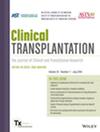Trends, Clinical Characteristics, and Outcomes of Percutaneous Coronary Intervention in Liver Transplant Recipients
Abstract
Background
Coronary artery disease (CAD) poses a significant challenge for liver transplant recipients (LTRs) who face higher cardiovascular risks due to immunosuppressive therapies and metabolic changes. While extensive research has focused on CAD management in patients awaiting liver transplantation, data on the outcomes of percutaneous coronary intervention (PCI) in the post-transplant population remain limited.
Methods
This retrospective cohort study used the National Inpatient Sample database (2016–2021) to evaluate PCI hospitalizations involving LTR and non-transplant patients. Propensity score matching (1:3) was applied to balance the covariates between the LTRs and non-transplant patients. The primary outcome was in-hospital mortality.
Results
Among the 2 681 545 PCI hospitalizations, LTRs accounted for 0.1% (n = 2675). LTRs were more likely to have diabetes (60.56% vs. 41.36%) and chronic kidney disease (60.93% vs. 21.06%) but less likely to have hyperlipidemia (58.32% vs. 72.65%; all p < 0.001). The crude rates of AKI (32.34% vs. 16.07%; p < 0.001) and blood transfusion (5.61% vs. 2.76%; p = 0.0001) were higher in the LTRs. After matching, the LTRs were associated with lower odds of in-hospital mortality (OR, 0.55; 95% CI, 0.30–1.00; p = 0.05) and cardiogenic shock (OR, 0.46; 95% CI, 0.29–0.74; p = 0.001). PCI hospitalizations among LTRs increased over time, peaking in 2019 (116.6/100 000).
Conclusion
Despite higher comorbidities and complication rates, LTRs undergoing PCI exhibited lower in-hospital mortality than non-transplant patients, likely reflecting survivor bias, rigorous pre- and post-transplant care, and specialized management. These preliminary findings highlight the need for further studies with detailed clinical data to validate the current findings.

 求助内容:
求助内容: 应助结果提醒方式:
应助结果提醒方式:


